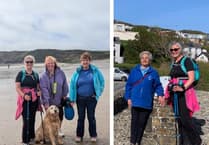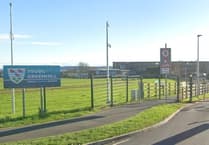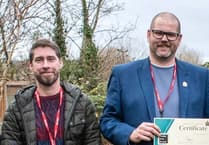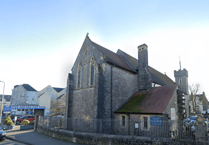Sir,
Sunday, August 2: My husband and I arrived in Tenby, at the Clarence Hotel, after a very long bus ride from Royston, Herts, with many changes. After dinner we decided to go for a walk to get our bearings. On our way out we met a couple from our coach called Jerry and Lyn. Jerry was born in Tenby, but had moved away. His cousin, Betty Beynon, still lives here and they were going to ask her to come and meet me, to see if she could throw any light on my memories of 1940, when I came to Tenby with my mother to see my father, who was stationed here in the 2/9th Manchester Regiment. I have a memory of looking down onto the beach and seeing soldiers in army kit asleep on the beach. I have wondered throughout the last 69 years if they had been brought there from Dunkirk!
We went for a walk into the town and into the British Legion Club. There were very few people there. Right at the back, up some steps, we noticed three men. They were brothers and one of them was Mr. Eric Powling. They only meet in the British Legion Club on a Sunday evening.
Mr. Powling confirmed that Belgian troops came to Tenby from Dunkirk and slept on the beach as they had nowhere else to go. Later on, families took them in and then accommodation was built for them. The Belgians built two large air raid shelters by the Powlings' home in Newell Hill. The Belgian soldiers trained and formed the Piron Brigade (apparently named after a Brigadier General in the Belgian Army) and returned to France later, and fought their way back to Belgium. Mr. Powling also told me that there was a soldier from the Manchester Regiment commemorated on the War Memorial.
We walked to the War Memorial and saw on the Roll of Honour the name of Pte G. H. Williams of the Manchester Regiment.
Wednesday, August 5: Betty Beynon (cousin of Lyn and Jerry) arrived at the Clarence Hotel to talk to us. She told us that at the end of the promenade was Shanleys. This building had a roof garden, a ballroom and a skating rink. It was turned into a billet for the Belgian troops.
Betty told us that if we went to the café on Castle Beach between 9 and 9.30 am, Ivor Smith and Gwyn Jenkins always went there for breakfast and she thought they would be able to help us. We decided to go there on Thursday.
Our next port of call was the Tenby Observer. I had phoned Andy before coming to Tenby to ask if I could see old copies of the paper which are now on fiche. There were many references to the BEF and how some of the men, both British and Belgian, came to Tenby from the Dunkirk beaches. Patrick printed pages for me, about their return to Tenby.
We walked up to the museum hoping to buy a copy of John Tipton's book 'Tenby in WW2', but unfortunately it had sold out. I'm hoping to get a copy later. It contains photos of troops on the sands.
We called in at the Cofion bookshop, but unfortunately Albie did not have a copy either.
We went into the Tudor Merchant's House, a small but fascinating National Trust property off Tudor Square. As usual, I told people the reason for my return to Tenby, and got talking to Alison. She told me that one of her relatives, Pte George Henry Williams, was in the Manchester Regiment and his name was on the War Memorial. I showed her the photo I had taken earlier, on my digital camera of his name.
We walked to the Norton Hotel where the Manchester Regiment had had their headquarters. The present owners have only been there a few years so could not help us in our search, but were very welcoming and showed us round.
Thursday, August 6: We walked to the Castle Beach Café to see if Gwyn Jenkins, Ivor Smith and John Wickland turned up. They told us about the military cemeteries in the area, one at Cheriton (Milton Airfield) and one at Pembroke Dock. Unfortunately, we were not able to visit them.
In 1940, the Ex-Servicemen's Club opened to soldiers brought from Dunkirk to the south coast and then on trains to Tenby.
South Cliff Street (Hanover Court) used the garage belonging to George Ace and had about 100 men sleeping on straw palliasses.
We heard that after the Belgians arrived in Tenby, they built three villages out at Pendine Sands, one of which became a children's camp called Llanmiloe Village. They did gunnery training. Apparently the coast around here is very much like Cherbourg.
Penally Rifle Range and the trenches have been there since WW1. Much later on, the harbour had a lot of landing craft in it. Everyone, even schoolchildren, had to have a permit to go near to the harbour or the town. Curfew was 10.30 pm.
Hugh Lloyd then joined us; he lives next door to Gwyn Jenkins and went to school with John Wickland. They told us that some of the troops in the area around Tenby included the Kings Shropshire Light Infantry, The Buffs and the 2/9th Manchester Regiment.
The Marines were at Saundersfoot and Pembroke was a garrison town protecting the oil terminal.
We went back to the museum with its fascinating history of Tenby through the ages. One exhibit was about WW2 and said that during this period Tenby's hotels were requisitioned by the government. After the retreat from Dunkirk in 1940, Belgian troops and up to 2,000 British troops were deployed in the area. The Belgian HQ was at the Atlantic Hotel, while the British HQ was at the Norton. The burrows behind the South Beach were wired and mined and the beach obstructed against possible landings.
We went to the Atlantic Hotel, as it had been the headquarters of the Belgians. In the entrance there is a blue plaque which says '1940 HQ of the First Belgian Fusilier Battalion formed in Tenby, which became the Belgian Liberation Brigade'.
This brought our holiday in Tenby to an end. I am so grateful to the people of Tenby for all their help.
Mrs. Patricia Smith,
Royston,
Herts.



